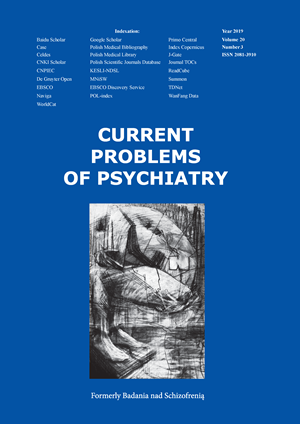Diagnoza i konstruowanie zaburzeń spójności wypowiedzi w schizofazji
DOI:
https://doi.org/10.2478/cpp-2019-0012Słowa kluczowe:
schizofrenia, spójność, zaburzenia językoweAbstrakt
Wstęp. Zaburzenia językowe, określane jako schizofazja, stanowią jeden z kluczowych objawów schizofrenii, zwłaszcza w postaci zdezorganizowanej choroby, co znalazło swoje odbicie w opisie „luźnych asocjacji” jako jednego z osiowych objawów schizofrenii wg P.E. Bleulera. Obecnie za podstawę lingwistyczną schizofazji uważa się dezorganizację tekstu na poziomie zaburzeń spójności dyskursu i zubożenia syntaktycznego na poziomie zdania. Najczęściej używanym narzędziem do klinicznej oceny schizofazji jest stworzona przez N. Andreasen the Assessment of Thought, Language, and Communication (Skala do oceny myślenia, języka i komunikacji).
Cele pracy. W pracy przedstawiono próbki językowe pacjentów cierpiących na schizofrenię z dużym nasileniem schizofazji, ale przede wszystkim stworzone przez studentów logopedii próbki tekstu, które miały symulować patologię językową osób chorych. Celem pracy było porównanie tych dwu korpusów tekstu, tak by ocenić w jaki sposób zajęcia na temat schizofazji wpływają na rozumienie specyficznych fenomenów językowych z zakresu zaburzeń spójności tekstu, takich jak: zbaczanie wypowiedzi, rozkojarzenie, roztargnienie czy utrata celu.
Materiał badawczy.
- Korpus tekstu uzyskany od dwóch pacjentów chorujących na schizofrenię z wysokim poziomem schizofazji.
- Korpus tekstu skonstruowany przez dwóch studentów logopedii, w czasie zająć akademickich na temat schizofazji.
Wyniki. W pracy przedstawiono próbki językowe pacjentów cierpiących na schizofrenię z dużym nasileniem schizofazji, ale przede wszystkim stworzone przez studentów logopedii próbki tekstu, które miały symulować patologię językową osób chorych.
Wnioski. Istotą zaburzeń językowych typu schizofazji wydają się być zaburzenia spójności tekstu na poziomie pragmatycznym, semantycznym i syntaktycznym. Zaprezentowane wypowiedzi schizofatyczne, których autorami są studenci logopedii są bardzo zbliżone do autentycznych próbek schizofazji – świadczą o zrozumieniu tego czym jest schizofazja. Można sądzić, że prezentacja zaburzeń językowych z tekstów pacjentów chorujących na schizofrenię, a następnie próba stworzenia wypowiedzi analogicznych sprzyja lepszemu rozumieniu istoty schizofazji, a więc dezorganizacji tekstu na poziomie budowy całości wypowiedzi, ale także na poziomie zdania (wypowiedzenia) w postaci zubożenia syntaktycznego.
Bibliografia
1. American Psychiatric Association: Diagnostic and Statistical Manual of Mental Disorders Fifth Version (DSM-5) (2013) Washington D.C.
2. Crow TJ. Is schizophrenia the price that Homo sapiens pays for language? Schizophr Res. 1997 Dec 19;28(2-3):127-41
3. Reilly F, Harrow M, Tucker G, Quinlan D, Siegel A. Looseness of associations in acute schizophrenia. Br J Psychiatry. 1975 Sep;127:240-6
4. Andreasen N. (1979a): Thought, language, and communication disorders. I. Clinical assessment, definition of terms, and evaluation o f t heir r eliability. A rch G en P sychiatry, 3 6, 1 315-1321.
5. Andreasen N. (1979b): Thought, language, and communication disorders. II. Diagnostic significance. Arch Gen Psychiatry, 36, 1325-1330
6. Czernikiewicz A. (2004): Przewodnik po zaburzeniach językowych w schizofrenii. IPiN Warszawa
7. Czernikiewicz A., Woźniak T. (2012): Diagnoza psychogennych zaburzeń mowy, (w:) Diagnoza logopedyczna, pod red. S. Milewskiego i E. Czaplewskiej, Gdańsk, GWP, 415-480
8. Woźniak T. (2000): Zaburzenia języka w schizofrenii, Lublin, Wydawnictwo UMCS.
Pobrania
Opublikowane
Numer
Dział
Licencja
Prawa autorskie (c) 2019 Autorzy

Praca jest udostępniana na licencji Creative Commons Attribution-NonCommercial-NoDerivatives 3.0 Unported License.


